On the Use of Cloud Analysis for Structural Glass Members under Seismic Events
Abstract
:1. Introduction
2. State-of-Art and Literature Review on q-factor Methods
3. q-factor and Selected Calculation Methods
- for structural components, by inter-story drift ratios (IDR), with inelastic component deformations and associated forces;
3.1. Dynamic (or PGA) Method (M1)
3.2. Mixed Method (M2)
3.3. Cloud Analysis (M3) with Linear Regression
4. Case-Study Glass Frame
4.1. Geometrical and Mechanical Properties
4.2. Preliminary Elastic Seismic Design of the Frame
- W the aboveground total mass of the building object of analysis,
- Sd(T1) the design acceleration from the reference spectrum, as a function of the vibration period T1, with Sd = 0.35 g the peak ground acceleration (high seismic region of Italy),
- λ = 1 a correction factor for one-story buildings with T1 > 2TC (otherwise 0.85), and
- q ≥ 1 the behavior factor of the system.
5. Finite Element Numerical Investigation
5.1. Numerical Model
5.2. Materials and Contact Interactions
5.3. Loading Strategy
- S1 = an initial stage for introduction of dead and accidental loads (5 s), followed by
- S2 = seismic analysis of the pre-loaded glass frame (60 s).
6. Discussion of M1 and M2 Results
6.1. Detection of First Yielding, Collapse, and Allowable Strength Parameters
- brittle elastic glass panels (with holes), and
- flexible angle brackets at the base of the frame.
- (C1) Tensile cracking of glass, close to the column base (region of holes),
- (C2) Compressive fracture of glass, close to the column base (region of holes),
- (C3) Ultimate deformation for steel angle brackets (plastic strain and vertical deformation, with δu =54.10 mm based on [19]),
- (C4) Possible yielding of steel bolts for the base connection.
6.2. Seismic Performance Assessment
6.3. q-factor Estimates
7. Cloud Analysis
7.1. Input Records and EDPs
7.2. Analysis of M3 Results with Linear Regression
7.3. Comparative q-factor Predictions
8. Conclusions
- IDA-based approaches (M1 or M2) are univocal in damage detection, thus in the corresponding estimation of reliable EDPs;
- Both M1 and M2 procedures are indeed strongly expensive in computational cost. The present study, for example, was based on a minimum of 7 accelerograms and required up to 140 non-linear dynamic analyses; and
- High sensitivity was observed for the predicted average q-values from M1 or M2, thus recommending a careful selection of input signals, but also the possible use of largest sets of scaled records.
- Confirmed the reduced computational cost of the approach, compared to M1 or M2 methods (60 unscaled signals and analyses in total for the present study, compared to 140 simulations); and
- Confirmed that reliable EDPs for special structures should be properly calculated, with the support of refined numerical models or even experimental tests. Existing consolidated EDPs of literature and standards for seismic-resistant structures can hardly adapt to special glass systems and members.
- However, the M3 procedure also gave evidence of some difficulties of dataset interpretation (due to limited stress/deformation levels in the load-bearing members, for some simulations). The reason was found in the set of unscaled input accelerograms that sometimes (when applied to structures characterized by limited self-weight and high flexibility as in the present study) can hardly achieve the desired EDPs at collapse; and
- Furthermore, the FE parametric study proved that—once EDPs and damage mechanisms for relevant limit states are established—the M3 approach can offer rather accurate predictions for glass structures under seismic loads, and thus support as an efficient tool the estimation of q-factor for the seismic design of similar structural systems. For the present case-study frame, the calculated q-factor was in fact in line, but on the conservative side compared to simple analytical predictions from [19], based on the local analysis of bracket ductility and stress peaks in the region of glass holes. Such a finding also confirms the need for complex numerical models able to capture dynamic mechanical phenomena in similar systems, as a more detailed investigation to combine with simplified analytical procedures.
Author Contributions
Funding
Institutional Review Board Statement
Informed Consent Statement
Data Availability Statement
Conflicts of Interest
Appendix A
| Event ID | Date | Soil Type | Mw | R (km) | PGA (m/s2) | Sa(T1) (m/s2) |
|---|---|---|---|---|---|---|
| ME-1979-0003 | 15/04/1979 | B | 6.9 | 6.8 | 3.53 | 7.39 |
| ME-1979-0003 | 15/04/1979 | A | 6.9 | 62.9 | 2.11 | 7.50 |
| ME-1979-0003 | 15/04/1979 | B | 6.9 | 19.7 | 2.98 | 7.89 |
| ME-1979-0003 | 15/04/1979 | B | 6.9 | 19.7 | 4.45 | 10.52 |
| ME-1979-0003 | 15/04/1979 | A | 6.9 | 19.7 | 1.73 | 6.29 |
| ME-1979-0003 | 15/04/1979 | B | 6.9 | 22 | 2.77 | 8.39 |
| GR-1986-0006 | 13/09/1986 | B | 5.9 | 6.6 | 2.28 | 6.52 |
| GR-1986-0006 | 13/09/1986 | B | 5.9 | 6.6 | 2.65 | 10.61 |
| GR-1986-0006 | 13/09/1986 | B | 5.9 | 5.5 | 2.91 | 10.23 |
| EMSC-20161030_0000029 | 30/10/2016 | A | 6.5 | 18.6 | 4.26 | 13.57 |
| EMSC-20161030_0000029 | 30/10/2016 | A | 6.5 | 18.6 | 3.85 | 11.29 |
| EMSC-20160824_0000006 | 24/08/2016 | B | 6 | 8.5 | 8.51 | 17.94 |
| EMSC-20161030_0000029 | 30/10/2016 | B | 6.5 | 26.4 | 3.94 | 13.02 |
| IT-2009-0009 | 06/04/2009 | B | 6.1 | 5 | 4.37 | 9.72 |
| IT-2009-0009 | 06/04/2009 | B | 6.1 | 4.9 | 5.35 | 12.93 |
| EMSC-20161030_0000029 | 30/10/2016 | A | 6.5 | 7.8 | 4.19 | 9.63 |
| EMSC-20161030_0000029 | 30/10/2016 | A | 6.5 | 7.8 | 5.71 | 15.72 |
| EMSC-20161026_0000095 | 26/10/2016 | B | 5.9 | 14 | 5.39 | 9.29 |
| EMSC-20161026_0000095 | 26/10/2016 | B | 5.9 | 39.1 | 2.40 | 8.90 |
| EMSC-20161030_0000029 | 30/10/2016 | B | 6.5 | 4.6 | 4.76 | 18.63 |
| EMSC-20160824_0000006 | 24/08/2016 | B | 6 | 15.3 | 3.67 | 6.61 |
| EMSC-20161030_0000029 | 30/10/2016 | B | 6.5 | 4.6 | 3.65 | 11.00 |
| IT-1980-0012 | 23/11/1980 | B | 6.9 | 33.3 | 3.14 | 10.87 |
| IT-1980-0012 | 23/11/1980 | B | 6.9 | 33.3 | 2.21 | 6.34 |
| EMSC-20161030_0000029 | 30/10/2016 | B | 6.5 | 22.6 | 4.74 | 7.79 |
| EMSC-20161030_0000029 | 30/10/2016 | A | 6.5 | 12 | 7.79 | 13.17 |
| EMSC-20161030_0000029 | 30/10/2016 | A | 6.5 | 12 | 8.50 | 14.17 |
| EMSC-20161030_0000029 | 30/10/2016 | B | 6.5 | 11.4 | 5.93 | 15.88 |
| EMSC-20161030_0000029 | 30/10/2016 | B | 6.5 | 11.4 | 4.13 | 14.21 |
| EMSC-20161030_0000029 | 30/10/2016 | B | 6.5 | 9.9 | 2.60 | 5.39 |
| EMSC-20161030_0000029 | 30/10/2016 | B | 6.5 | 26.1 | 4.45 | 7.34 |
| EMSC-20161030_0000029 | 30/10/2016 | B | 6.5 | 26.1 | 4.36 | 7.63 |
| TK-2003-0038 | 01/05/2003 | B | 6.33 | 11.8 | 5.09 | 10.73 |
| TK-1999-0077 | 17/08/1999 | A | 7.6 | 3.5 | 2.29 | 11.07 |
| ME-1979-0012 | 24/05/1979 | B | 6.2 | 8.3 | 2.61 | 4.60 |
| ME-1979-0003 | 15/04/1979 | A | 6.9 | 19.7 | 2.10 | 4.90 |
| ME-1979-0003 | 15/04/1979 | B | 6.9 | 22 | 2.32 | 5.30 |
| GR-1986-0011 | 15/09/1986 | B | - | 14.2 | 1.38 | 4.68 |
| GR-1993-0027 | 14/07/1993 | B | 5.6 | 4.9 | 3.95 | 4.33 |
| GR-1990-0002 | 17/05/1990 | B | - | 23 | 1.98 | 5.58 |
| GR-1986-0006 | 13/09/1986 | B | 5.9 | 5.5 | 2.12 | 5.52 |
| IT-1976-0002 | 06/05/1976 | B | 6.4 | 27.7 | 3.10 | 6.47 |
| EMSC-20160903_0000063 | 03/09/2016 | A | 4.3 | 3.6 | 1.45 | 2.51 |
| EMSC-20161030_0000029 | 30/10/2016 | B | 6.5 | 20 | 2.86 | 2.54 |
| EMSC-20161101_0000060 | 01/11/2016 | A | 4.8 | 18.7 | 0.61 | 1.60 |
| EMSC-20161030_0000029 | 30/10/2016 | B | 6.5 | 39.2 | 0.92 | 2.82 |
| EMSC-20161030_0000029 | 30/10/2016 | B | 6.5 | 39.2 | 0.91 | 1.83 |
| EMSC-20161030_0000029 | 30/10/2016 | B | 6.5 | 39.2 | 0.96 | 2.95 |
| EMSC-20161026_0000077 | 26/10/2016 | B | 5.4 | 7.7 | 2.33 | 3.63 |
| EMSC-20161026_0000095 | 26/10/2016 | B | 5.9 | 9.2 | 2.16 | 3.87 |
| EMSC-20161030_0000029 | 30/10/2016 | B | 6.5 | 17.4 | 1.89 | 4.24 |
| ME-1979-0012 | 24/05/1979 | B | 6.2 | 33.3 | 1.97 | 3.51 |
| IT-2009-0102 | 07/04/2009 | B | 5.5 | 14.3 | 1.44 | 2.62 |
| EMSC-20161026_0000095 | 26/10/2016 | A | 5.9 | 10.8 | 1.89 | 4.41 |
| EMSC-20161026_0000095 | 26/10/2016 | A | 5.9 | 16.2 | 1.65 | 3.08 |
| EMSC-20161030_0000029 | 30/10/2016 | B | 6.5 | 8.2 | 2.45 | 4.82 |
| IT-1977-0008 | 16/09/1977 | B | 5.3 | 7.1 | 0.80 | 1.05 |
| IT-1976-0024 | 11/09/1976 | B | 5.2 | 6.1 | 1.87 | 5.68 |
| EMSC-20161026_0000077 | 26/10/2016 | B | 5.4 | 8.9 | 1.81 | 2.67 |
| EMSC-20161026_0000133 | 26/10/2016 | A | 4.5 | 5.6 | 1.89 | 3.21 |
References
- Haldimann, M.; Luible, A.; Overend, M. Structural Use of Glass; IABSE: Zurich (CH), Switzerland, 2008; ISBN 978-3-85748-119-2. [Google Scholar]
- Feldmann, M.; Kasper, R.; Abeln, B.; Cruz, P.; Belis, J.; Beyer, J.; Colvin, J.; Ensslen, F.; Eliasova, M.; Galuppi, L.; et al. Guidance for European Structural Design of Glass Components—Support to the Imple-Mentation, Harmonization and Further Development of the Eurocodes; Pinto, D., Denton, F., Eds.; Report EUR 26439-Joint Research Centre-Institute for the Protection and Security of the Citizen: Ispra, Italy, 2014. [Google Scholar] [CrossRef]
- Bedon, C.; Amadio, C.; Noé, S. Noé Safety Issues in the Seismic Design of Secondary Frameless Glass Structures. Safety 2019, 5, 80. [Google Scholar] [CrossRef] [Green Version]
- Sucuoglu, H.; Vallabhan, C.V.G. Behaviour of window glass panels during earthquakes. Eng. Struct. 1997, 19, 685–694. [Google Scholar] [CrossRef]
- Lago, A.; Sullivan, T.J. A Review of Glass Facade Systems and Research into the Seismic Design of Frameless Glass Facades; ROSE Research Report 2011/11; IUSS Press: Pavia, Italy, 2011; ISBN 978-88-6198-059-4. [Google Scholar]
- Baniotopoulos, C.C.; Chatzinikos, K.T. Glass facades of mid-rise steel buildings under seismic excitation. In Research in Architectural Engineering Series, Volume 1: EU COST C13 Glass and Interactive Building Envelopes; IOS Press: Amsterdam, The Netherlands, 2007; pp. 239–246. ISBN 978-1-58603-709-3. [Google Scholar]
- Sivanerupan, S.; Wilson, J.L.; Gad, E.F.; Lam, N.T.K. Drift performance of point fixed glass façade systems. Adv. Struct. Eng. 2014, 17, 1481–1495. [Google Scholar] [CrossRef]
- Martins, L.; Delgado, R.; Camposinhos, R.; Silva, T. Seismic behaviour of point supported glass panels. In Proceedings of the Challenging Glass 3. Bos, Delft, The Netherlands, 28–29 June 2012; Veer Louter, N., Ed.; IOS Press: Amsterdam, The Netherlands, 2012. [Google Scholar]
- Casagrande, L.; Bonati, A.; Occhiuzzi, A.; Caterino, N.; Auricchio, F. Numerical investigation on the seismic dissipation of glazed curtain wall equipped on high-rise buildings. Eng. Struct. 2019, 179, 225–245. [Google Scholar] [CrossRef]
- Bellamy, L.; Palermo, A.; Sullivan, T. Developing innovative facades with improved seismic and sustainability performance. In Proceedings of the 12th Conference on Advanced Building Skins, Bern, Switzerland, 2–3 October 2017. [Google Scholar]
- Bedon, C.; Amadio, C. Numerical assessment of vibration control systems for multi-hazard design and mitigation of glass curtain walls. J. Build. Eng. 2018, 15, 1–13. [Google Scholar] [CrossRef] [Green Version]
- Bukieda, P.; Engelmann, M.; Stelzer, I.; Weller, B. Examination of Laminated Glass with Stiff Interlayers—Numerical and Experimental Research. Int. J. Struct. Glas. Adv. Mater. Res. 2019, 3, 1–14. [Google Scholar] [CrossRef] [Green Version]
- Zhao, C.; Yang, J.; Wang, X.; Azim, I. Experimental investigation into the post-breakage performance of pre-cracked laminated glass plates. Constr. Build. Mater. 2019, 224, 996–1006. [Google Scholar] [CrossRef]
- Kuntsche, J.; Schuster, M.; Schneider, J. Engineering design of laminated safety glass considering the shear coupling: A review. Glas. Struct. Eng. 2019, 4, 209–228. [Google Scholar] [CrossRef]
- D’Ambrosio, G.; Galuppi, L.; Royer-Carfagni, G. Post-breakage in-plane stiffness of laminated glass: An engineering approach. Glas. Struct. Eng. 2019, 4, 421–432. [Google Scholar] [CrossRef]
- Bedon, C.; Zhang, X.; dos Santos, F.A.; Honfi, D.; Kozłowski, M.; Arrigoni, M.; Figuli, L.; Lange, D. Performance of structural glass facades under extreme loads—Design methods, existing research, current issues and trends. Constr. Build. Mater. 2018, 163, 921–937. [Google Scholar] [CrossRef]
- Eurocode 8: Design of Structures for Earthquake Resistance—Part 1: General Rules, Seismic Actions and Rules for Buildings; European Committee for Standardisation: Brussels, Belgium, 1998.
- Eurocode 3: Design of Steel Structures—Part 1–5: Plated Structural Elements; European Committee for Standardisation: Brussels, Belgium, 1993.
- Santarsiero, M.; Bedon, C.; Moupagitsoglou, K. Energy-based considerations for the seismic design of ductile and dissipative glass frames. Soil Dyn. Earthq. Eng. 2019, 125, 105710. [Google Scholar] [CrossRef]
- ATC3-06. Tentative Provisions for the Development of Seismic Regulations for Buildings; Applied Technology Council: Redwood City, CA, USA, 1978. [Google Scholar]
- Macedo, L.; Silva, A.; Castro, J.M. A more rational selection of the behaviour factor for seismic design according to Eurocode 8. Eng. Struct. 2019, 188, 69–86. [Google Scholar] [CrossRef]
- Costanzo, S.; Tartaglia, R.; DI Lorenzo, G.; De Martino, A. Seismic Behaviour of EC8-Compliant Moment Resisting and Concentrically Braced Frames. Buildings 2019, 9, 196. [Google Scholar] [CrossRef] [Green Version]
- Kappos, A. Evaluation of behaviour factors on the basis of ductility and overstrength studies. Eng. Struct. 1999, 21, 823–835. [Google Scholar] [CrossRef]
- Borzi, B.; Elnashai, A. Refined force reduction factors for seismic design. Eng. Struct. 2000, 22, 1244–1260. [Google Scholar] [CrossRef]
- Chryssanthopoulos, M.K.; Dymiotis, C.; Kappos, A. Probabilistic evaluation of behaviour factors in EC8-designed R/C frames. Eng. Struct. 2000, 22, 1028–1041. [Google Scholar] [CrossRef]
- Newmark, N.M.; Hall, W. Procedures and criteria for earthquake-resistant design. In Part of: Selected Papers By Nathan M. Newmark: Civil Engineering Classics; Reprinted from Building Practices for Disaster Mitigation; Building Science Series, No. 46,1973; Natl. Bureau of Standards: Gaithersburg, MD, USA, 1973; Volume 1, pp. 209–236. [Google Scholar]
- Megalooikonomou, K.G.; Parolai, S.; Pittore, M. Toward performance-driven seismic risk monitoring for geothermal platforms: Development of ad hoc fragility curves. Geotherm. Energy 2018, 6, 1–17. [Google Scholar] [CrossRef] [Green Version]
- Terrenzi, M.; Spacone, E.; Camata, G. Collapse limit state definition for seismic assessment of code-conforming RC buildings. Int. J. Adv. Struct. Eng. 2018, 10, 325–337. [Google Scholar] [CrossRef]
- D’Aragona, M.G.; Polese, M.; Prota, A. Stick-IT: A simplified model for rapid estimation of IDR and PFA for existing low-rise symmetric infilled RC building typologies. Eng. Struct. 2020, 223, 111182. [Google Scholar] [CrossRef]
- Follesa, M.; Fragiacomo, M.; Casagrande, D.; Tomasi, R.; Piazza, M.; Vassallo, D.; Canetti, D.; Rossi, S. The new provisions for the seismic design of timber buildings in Europe. Eng. Struct. 2018, 168, 736–747. [Google Scholar] [CrossRef]
- Pozza, L.; Scotta, R.; Trutalli, D.; Polastri, A.; Smith, I. Experimentally based q-factor estimation of cross-laminated timber walls. Struct. Build. 2016, 169, 492–507. [Google Scholar] [CrossRef] [Green Version]
- Magenes, G.; Modena, C.; da Porto, F.; Morandi, P. Seismic Behaviour and Design of New Masonry Buildings: Recent Developments and Consequent Effects of Design Codes. In Proceedings of the Eurocode 8 Perspectives from the Italian Standpoint Workshop; Edoardo, C., Ed.; CRC Press: Boca Raton, Florida, USA, 2009; pp. 199–212. [Google Scholar]
- Zonta, D.; Zanardo, G.; Modena, C. Experimental evaluation of the ductility of a reduced-scale reinforced masonry building. Mater. Struct. 2001, 34, 636–644. [Google Scholar] [CrossRef]
- Casalegno, C.; Russo, S.; Sciarretta, F. Numerical Analysis of a Masonry Panel Reinforced with Pultruded FRP Frames. Mech. Compos. Mater. 2018, 54, 207–220. [Google Scholar] [CrossRef]
- Mazzolani, F.M.; Della Corte, G.; D’Aniello, M. Experimental analysis of steel dissipative bracing systems for seismic upgrading. J. Civ. Eng. Manag. 2009, 15, 7–19. [Google Scholar] [CrossRef] [Green Version]
- D’Ayala, D.; Meslem, A.; Vamvatsikos, D.; Porter, K.; Rossetto, T.; Silva, V. Guidelines for Analytical Vulnerability Assessment of Low/Mid-Rise Buildings, Vulnerability Global Component Project; GEM Foundation: Dubai, United Arab Emirates, 2015. [Google Scholar] [CrossRef]
- Jalayer, F.; De Risi, R.; Manfredi, G. Bayesian Cloud Analysis: Efficient structural fragility assessment using linear regression. Bull. Earthq. Eng. 2015, 13, 1183–1203. [Google Scholar] [CrossRef]
- Zentner, I.; Gündel, M.; Bonfils, N. Fragility analysis methods: Review of existing approaches and application. Nucl. Eng. Des. 2017, 323, 245–258. [Google Scholar] [CrossRef] [Green Version]
- Bakalis, K.; Vamvatsikos, D. Seismic Fragility Functions via Nonlinear Response History Analysis. J. Struct. Eng. 2018, 144, 04018181. [Google Scholar] [CrossRef]
- Luzi, L.; Lanzano, G.; Felicetta, C.; D’Amico, M.C.; Russo, E.; Sgobba, S.; Pacor, F.; ORFEUSWorking Group, 5. Engineering Strong Motion Database (ESM) (Version 2.0). Ist. Naz. Geofis. Vulcanol. (INGV) 2020. [Google Scholar] [CrossRef]
- Kiani, J.; Camp, C.; Pezeshk, S. On the number of required response history analyses. Bull. Earthq. Eng. 2018, 16, 5195–5226. [Google Scholar] [CrossRef]
- Baltzopoulos, G.; Baraschino, R.; Iervolino, I. On the number of records for structural risk estimation in PBEE. Earthq. Eng. Struct. Dyn. 2018, 48, 489–506. [Google Scholar] [CrossRef]
- Bradley, B.A.; Pettinga, D.; Baker, J.W.; Fraser, J. Guidance on the Utilization of Earthquake-Induced Ground Motion Simulations in Engineering Practice. Earthq. Spectra 2017, 33, 809–835. [Google Scholar] [CrossRef] [Green Version]
- Evangelista, L.; Del Gaudio, S.; Smerzini, C.; D’Onofrio, A.; Festa, G.; Iervolino, I.; Landolfi, L.; Paolucci, R.; Santo, A.; Silvestri, F. Physics-based seismic input for engineering applications: A case study in the Aterno river valley, Central Italy. Bull. Earthq. Eng. 2017, 15, 2645–2671. [Google Scholar] [CrossRef]
- Hassan, H.M.; Fasan, M.; Sayed, M.A.; Romanelli, F.; ElGabry, M.N.; Vaccari, F.; Hamed, A. Site-specific ground motion modeling for a historical Cairo site as a step towards computation of seismic input at cultural heritage sites. Eng. Geol. 2020, 268, 105524. [Google Scholar] [CrossRef]
- Bedon, C.; Amadio, C. Design buckling curves for glass columns and beams. Proc. Inst. Civ. Eng. Struct. Build. 2015, 168, 514–526. [Google Scholar] [CrossRef]
- Santo, D.; Mattei, S.; Bedon, C. Elastic Critical Moment for the Lateral–Torsional Buckling (LTB) Analysis of Structural Glass Beams with Discrete Mechanical Lateral Restraints. Materials 2020, 13, 2492. [Google Scholar] [CrossRef]
- Amadio, C.; Bedon, C. A buckling verification approach for monolithic and laminated glass elements under combined in-plane compression and bending. Eng. Struct. 2013, 52, 220–229. [Google Scholar] [CrossRef]
- CNR-DT 210/2013. Istruzioni per la Progettazione, L’esecuzione ed il Controllo di Costruzioni con Elementi Strutturali di vetro [Guide for the Design, Construction and Control of Buildings with Structural Glass Elements]; National Research Council of Italy (CNR): Roma, Italy, 2013; (Italian Version); Available online: www.cnr.it/it/node/2630 (accessed on 17 August 2021).
- NTC2018. Norme Tecniche Per Le Costruzioni; Design Standard for Buildings; Ministero delle Infrastrutture e dei Trasporti: Roma, Italy. 17 Gennaio 2018 (In Italian)
- Pilkey, W.D. Peterson’s Stress Concentration Factors, 2nd ed.; John Wiley & Sons, Inc.: Hoboken, NJ, USA, 1997. [Google Scholar]
- Coker, E.G.; Filon, L.N.G. Photo-Elasticity; Cambridge University Press: London, UK, 1931. [Google Scholar]
- Frocht, M.M. Photoelasticity; Wiley: New York, NY, USA, 1949; Volume 1. [Google Scholar]
- Simulia. ABAQUS Computer Software; Dassault Systèmes: Providence, RI, USA, 2020. [Google Scholar]
- Iervolino, I.; Galasso, C.; Cosenza, E. REXEL: Computer aided record selection for code-based seismic structural analysis. Bull. Earthq. Eng. 2010, 8, 339–362. [Google Scholar] [CrossRef]
- FEMA 356. Prestandard and Commentary for the Seismic Rehabilitation of Buildings; FEMA Publication No. 356; American Society of Civil Engineers for the Federal Emergency Management Agency: Washington, DC, USA, 2000. [Google Scholar]
- SEAOC. Vision 2000: Performance Based Seismic Engineering of Buildings; Structural Engineers Association of California: Sacramento, CA, USA, 1995. [Google Scholar]
- UBC. Uniform Building Code; International Conference of Building Officials: Whittier, CA, USA, 1997. [Google Scholar]
- Bedon, C.; Rinaldin, G.; Fragiacomo, M.; Noè, S. q-factor estimation for 3D log-house timber buildings via Finite Element analyses. Soil Dyn. Earthq. Eng. 2019, 116, 215–229. [Google Scholar] [CrossRef]

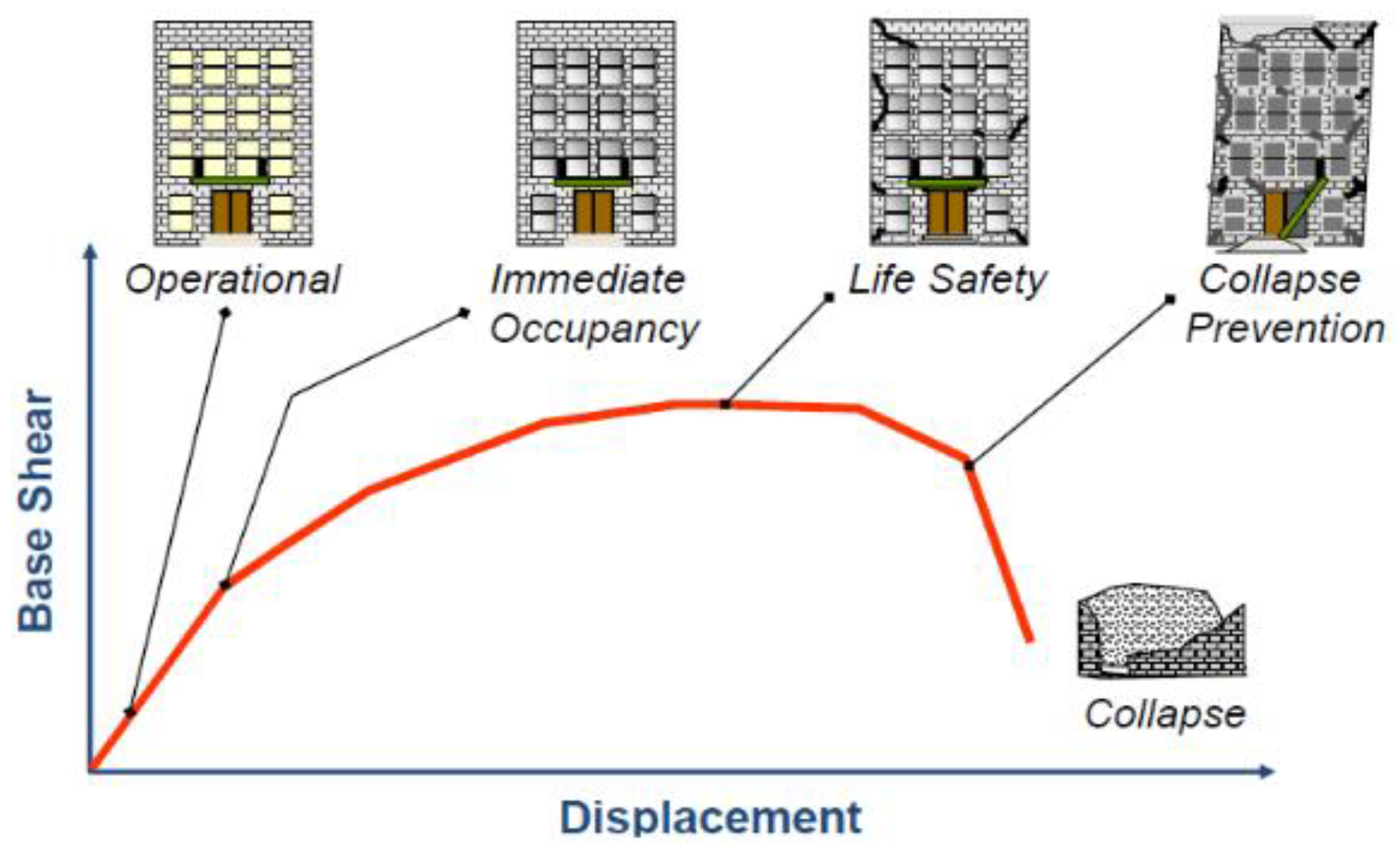
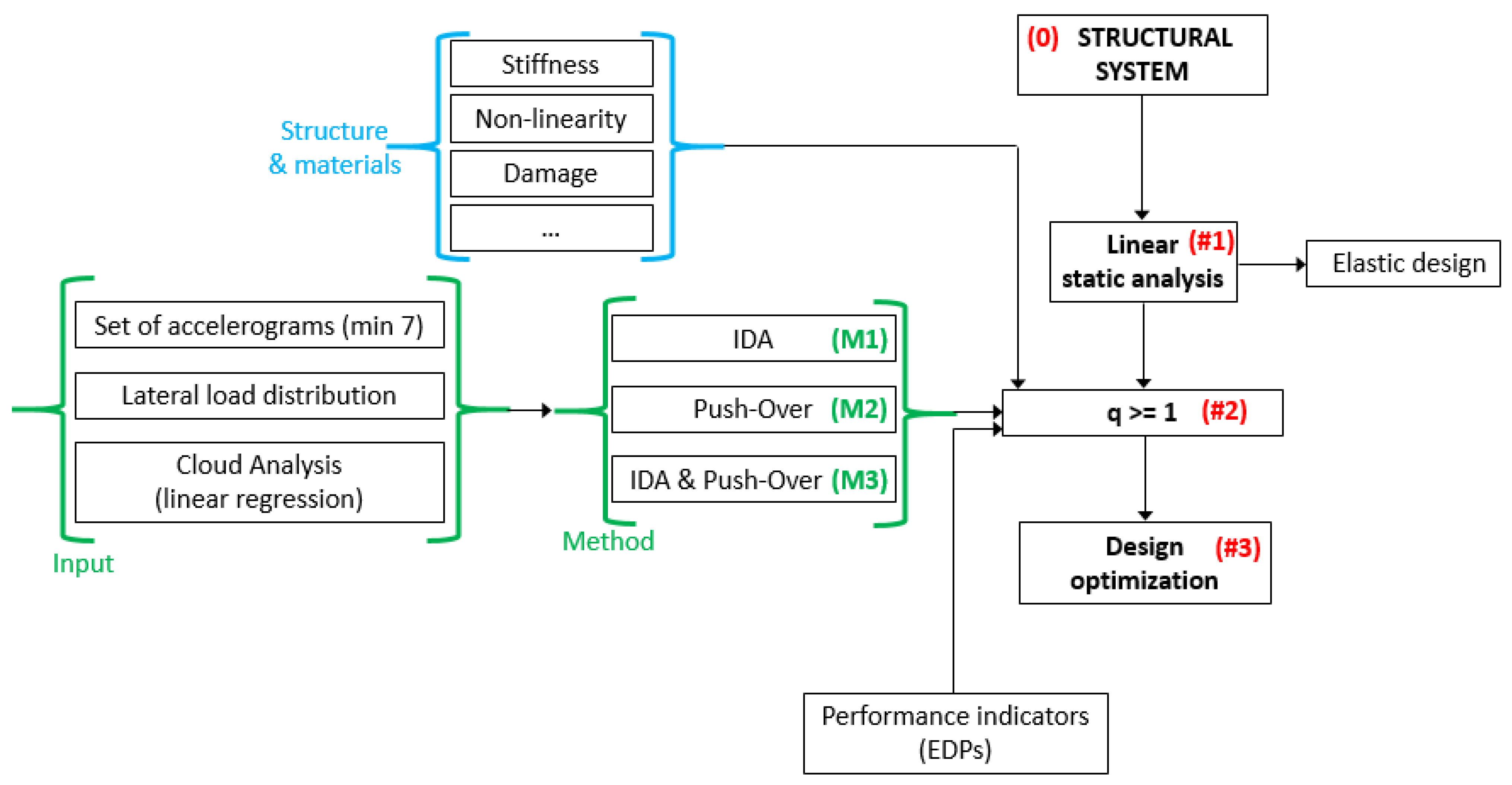
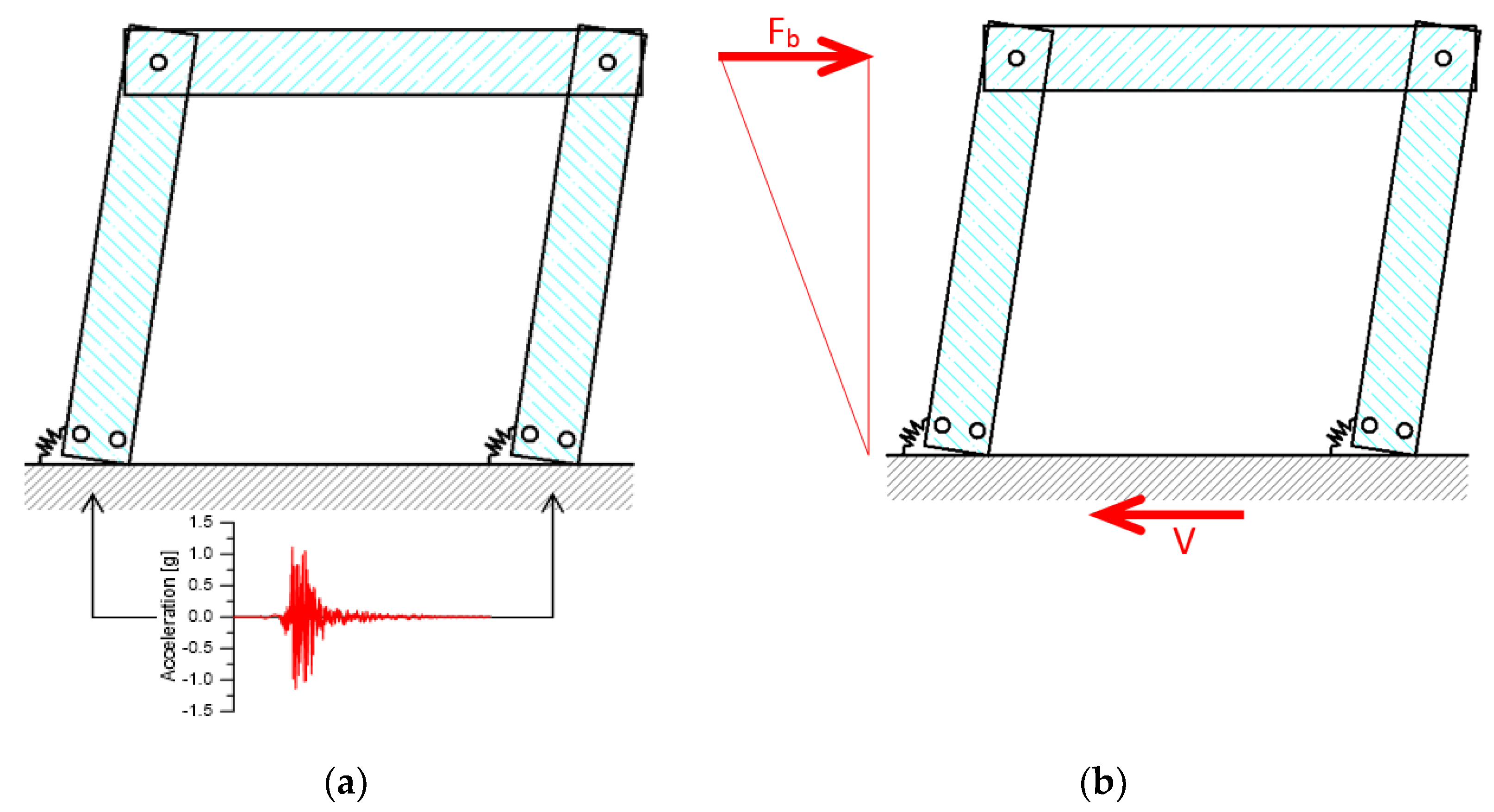
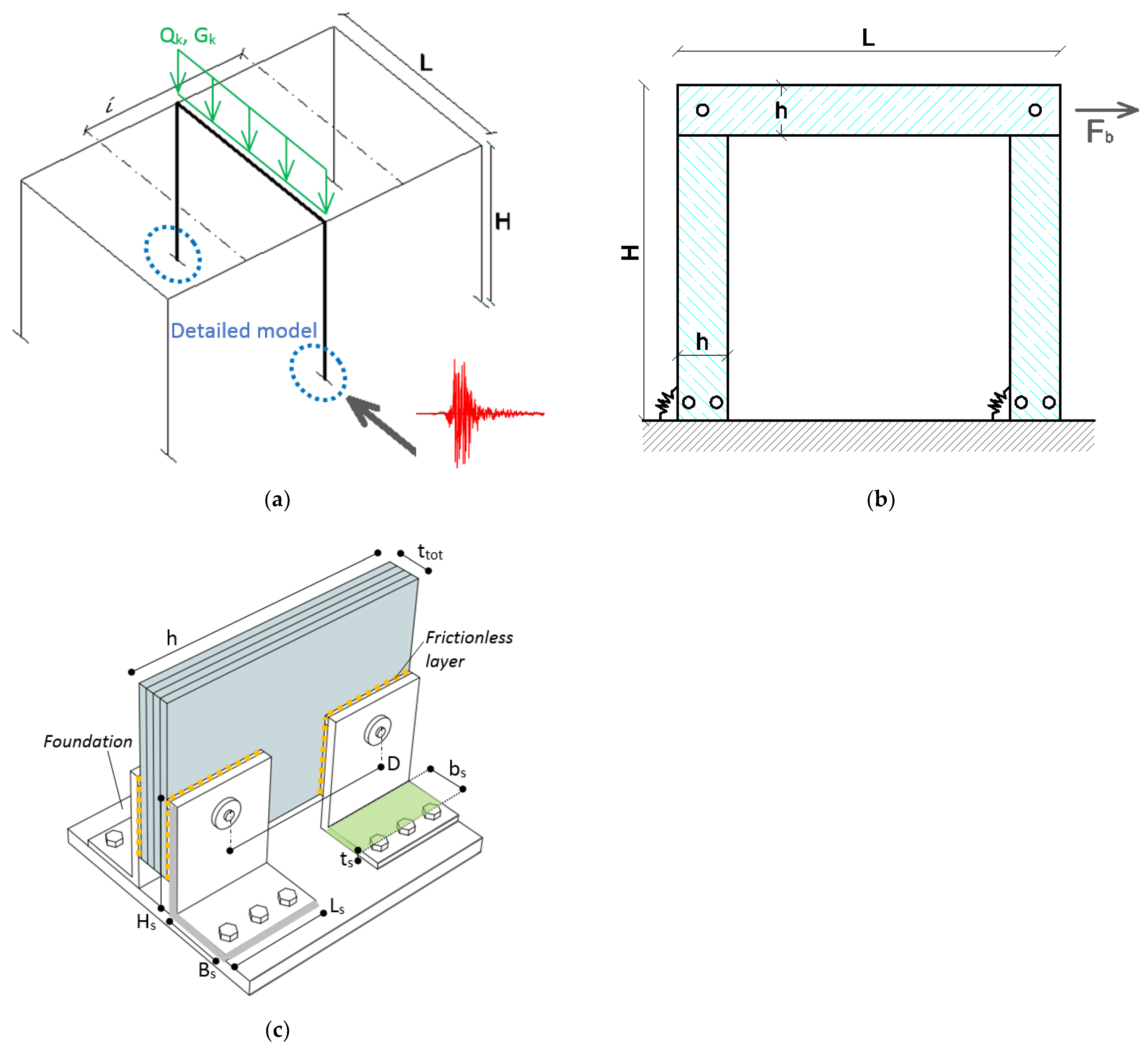
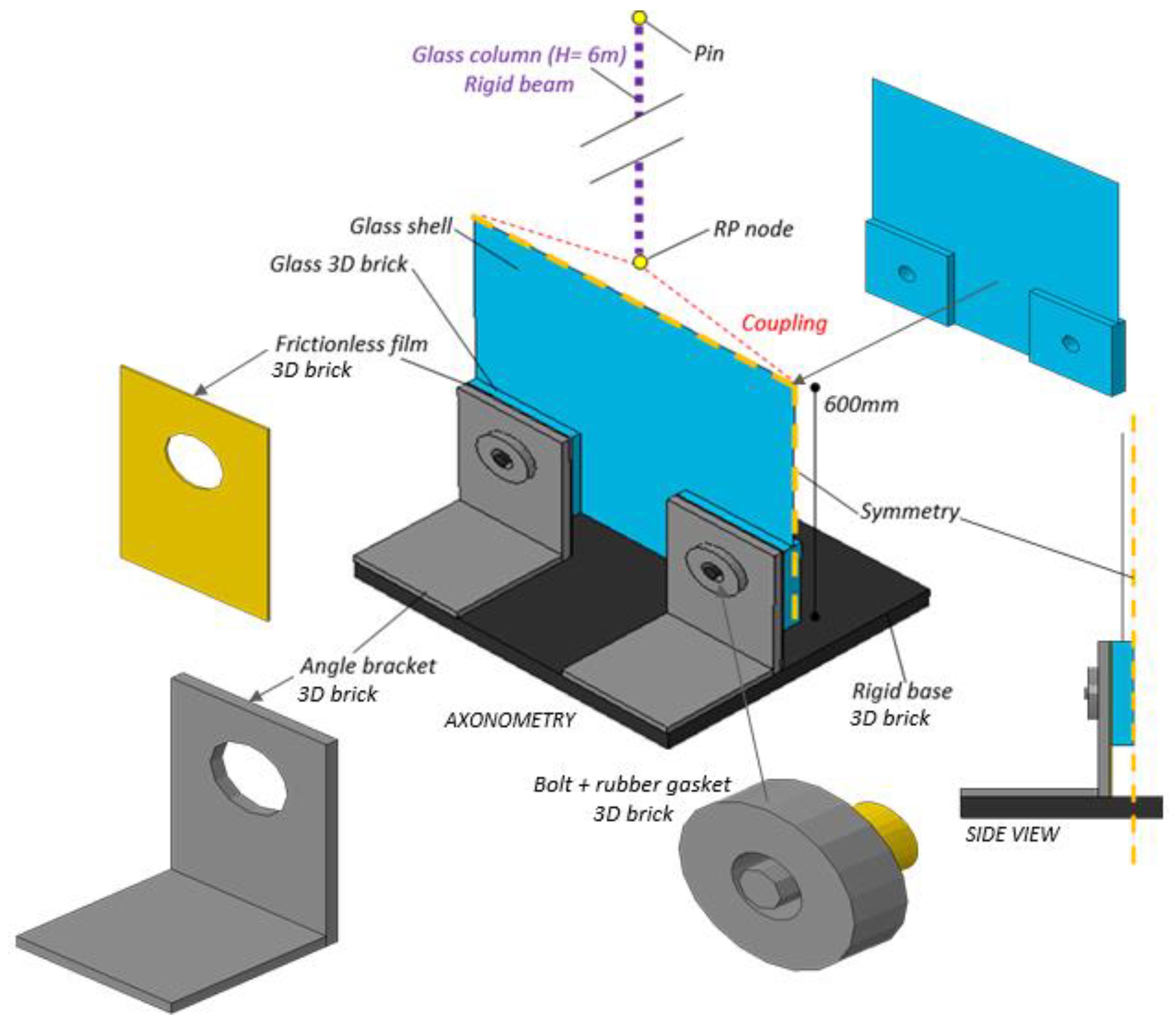
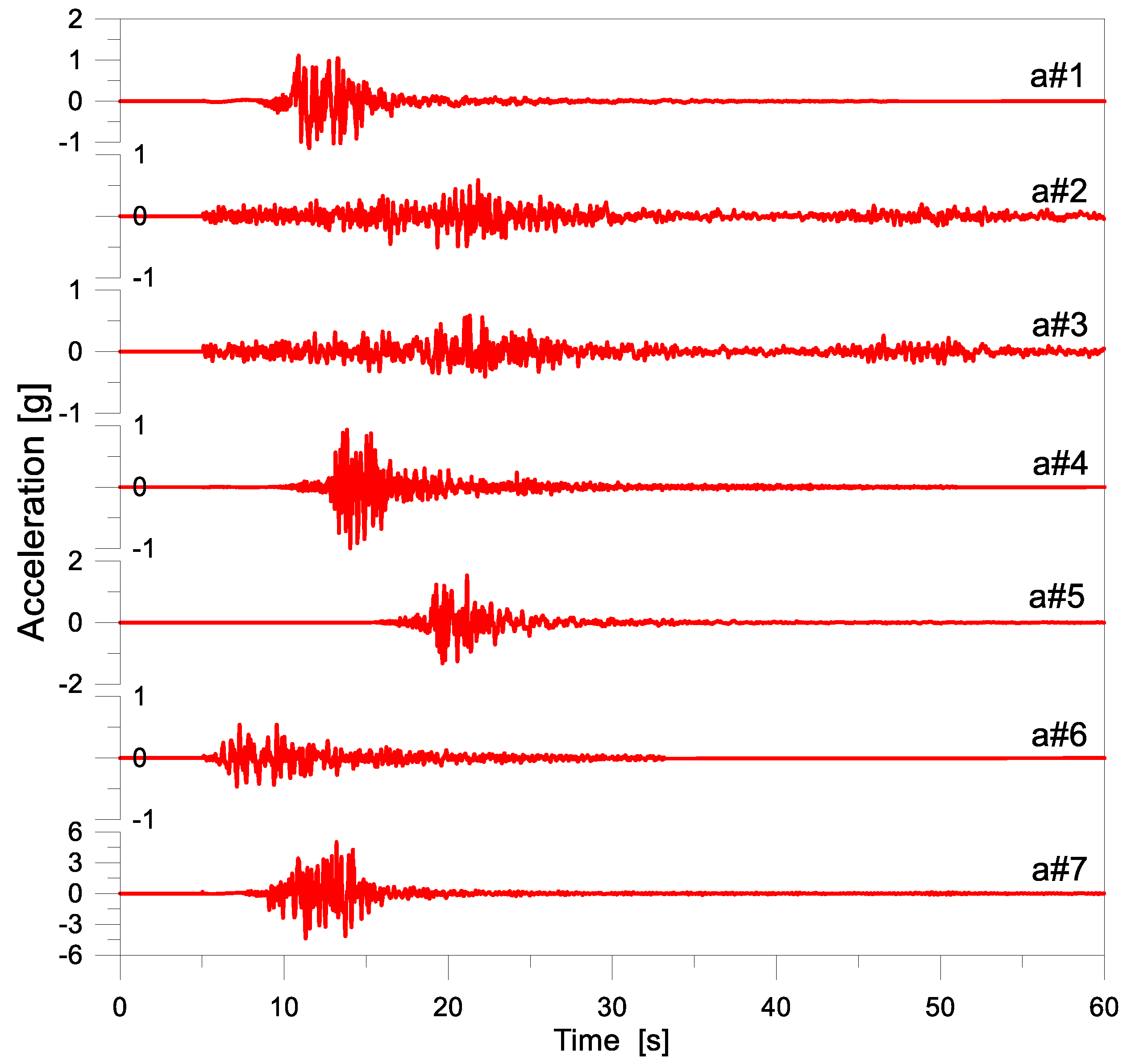

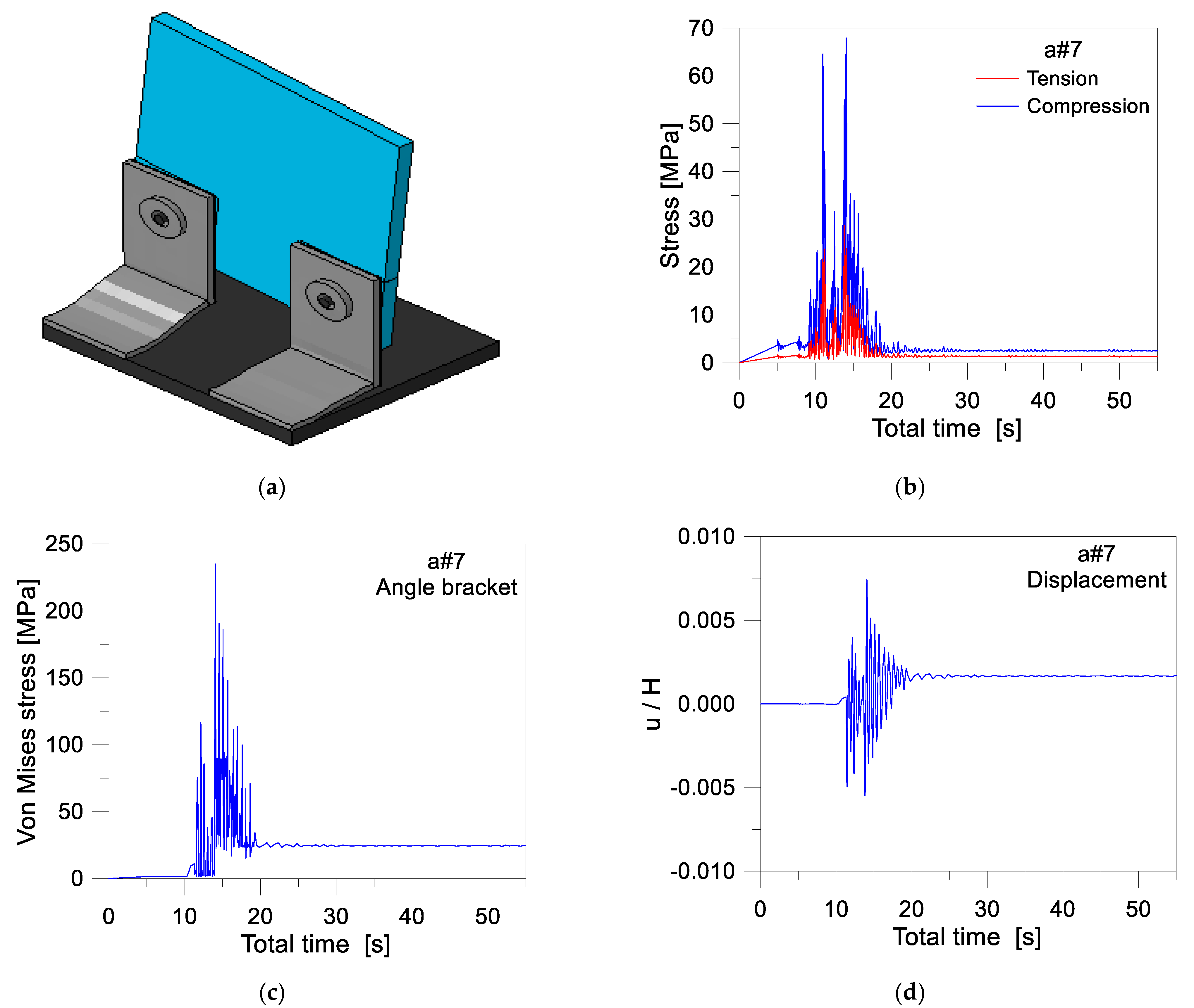
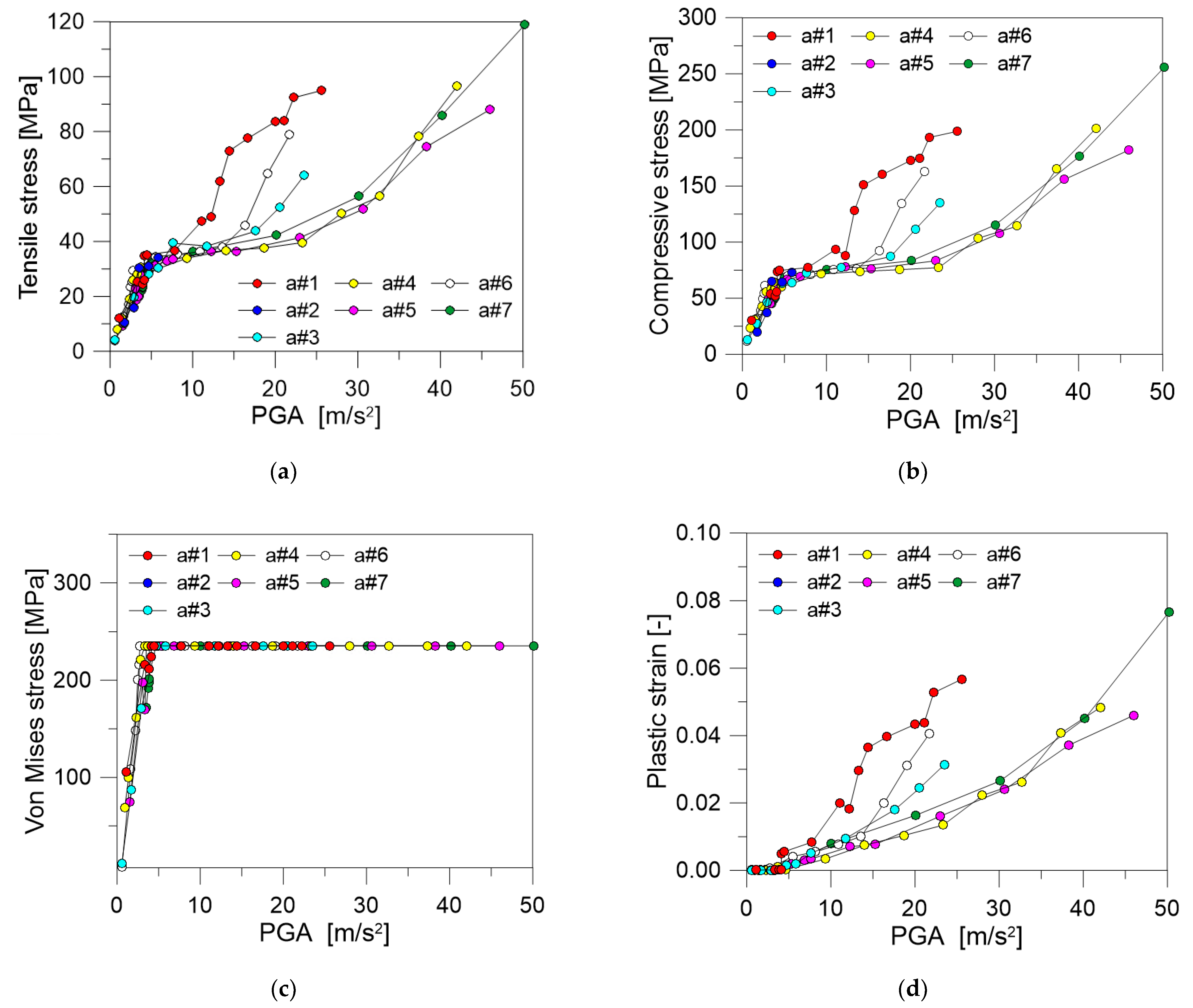

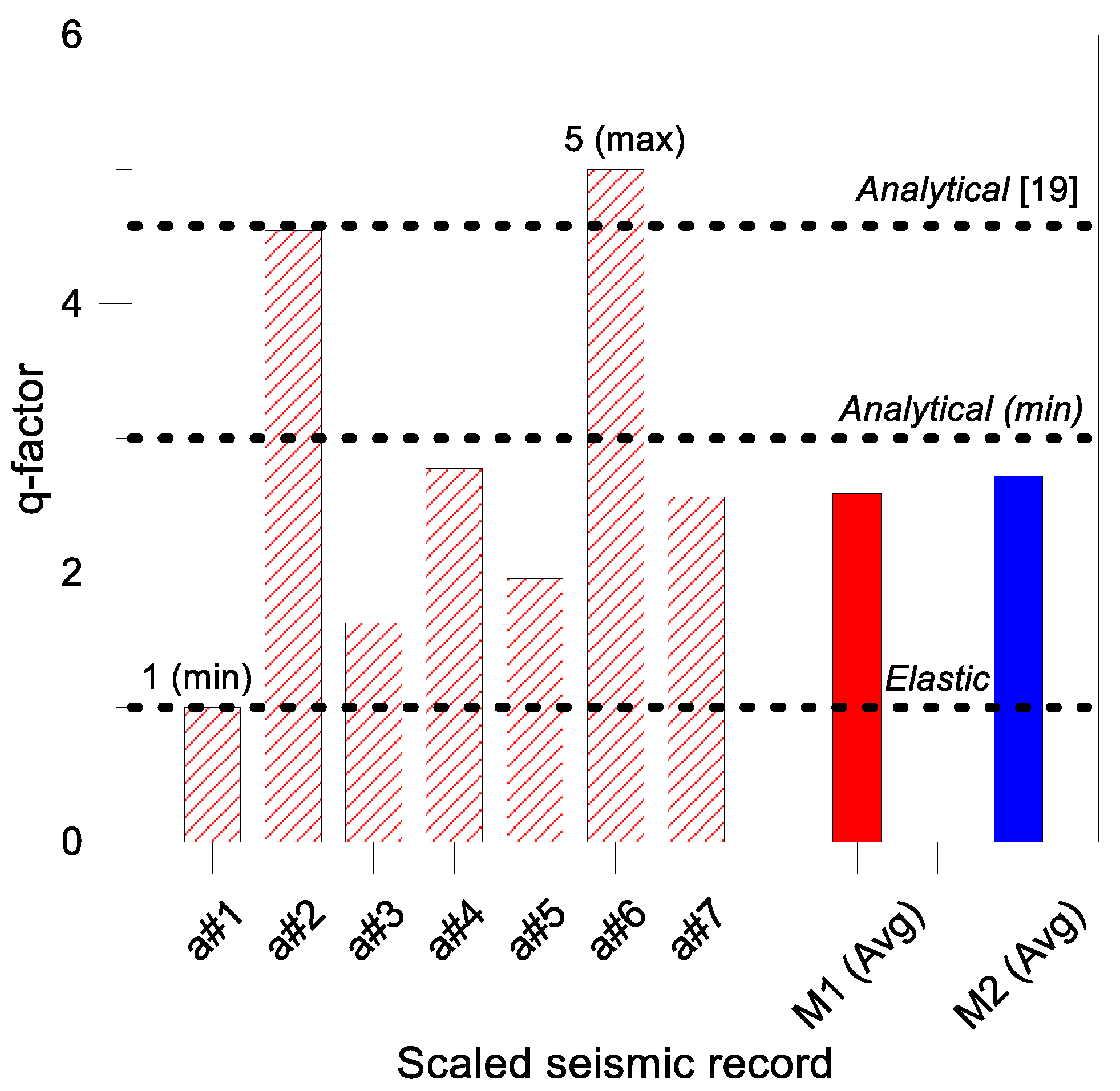
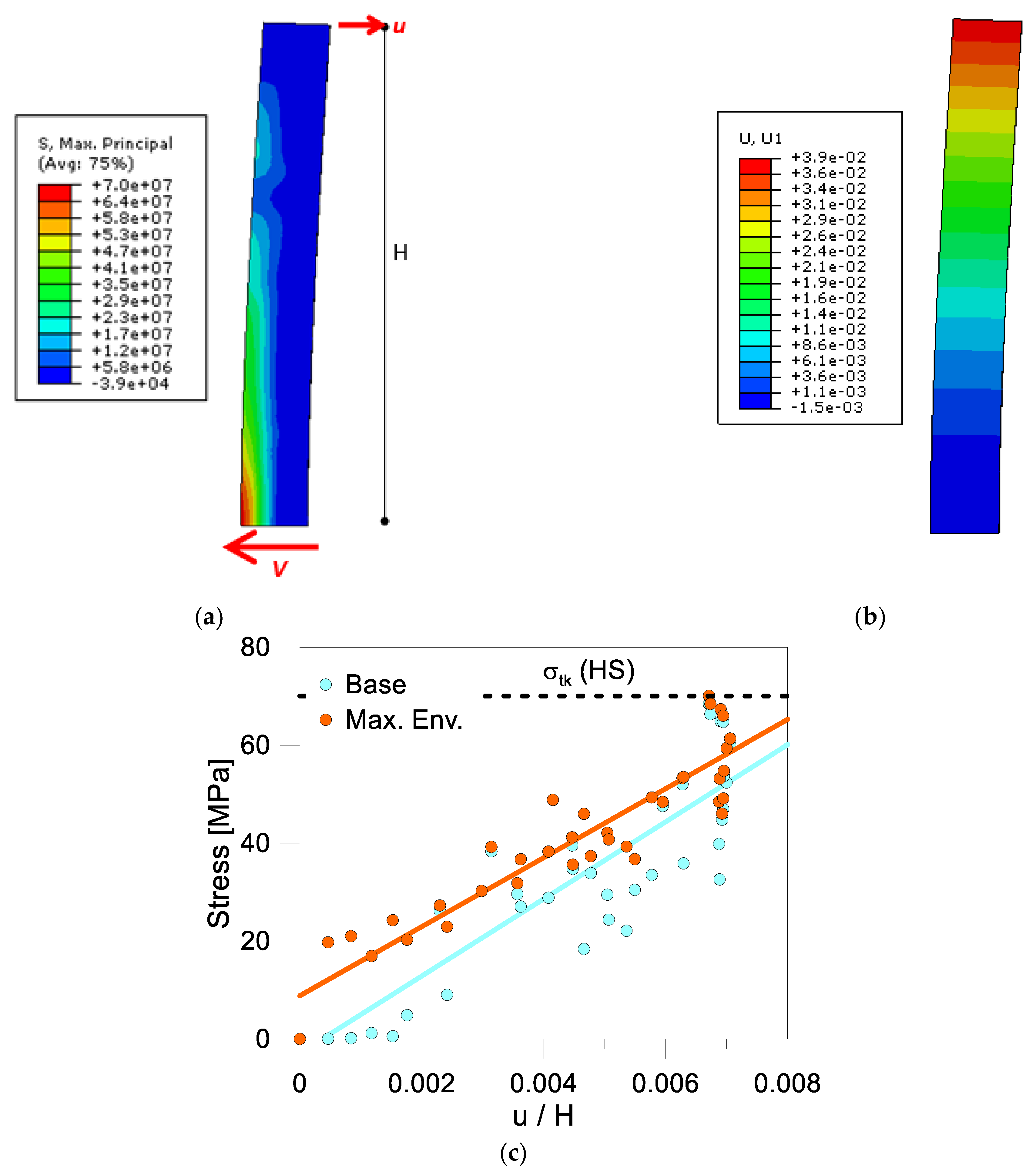
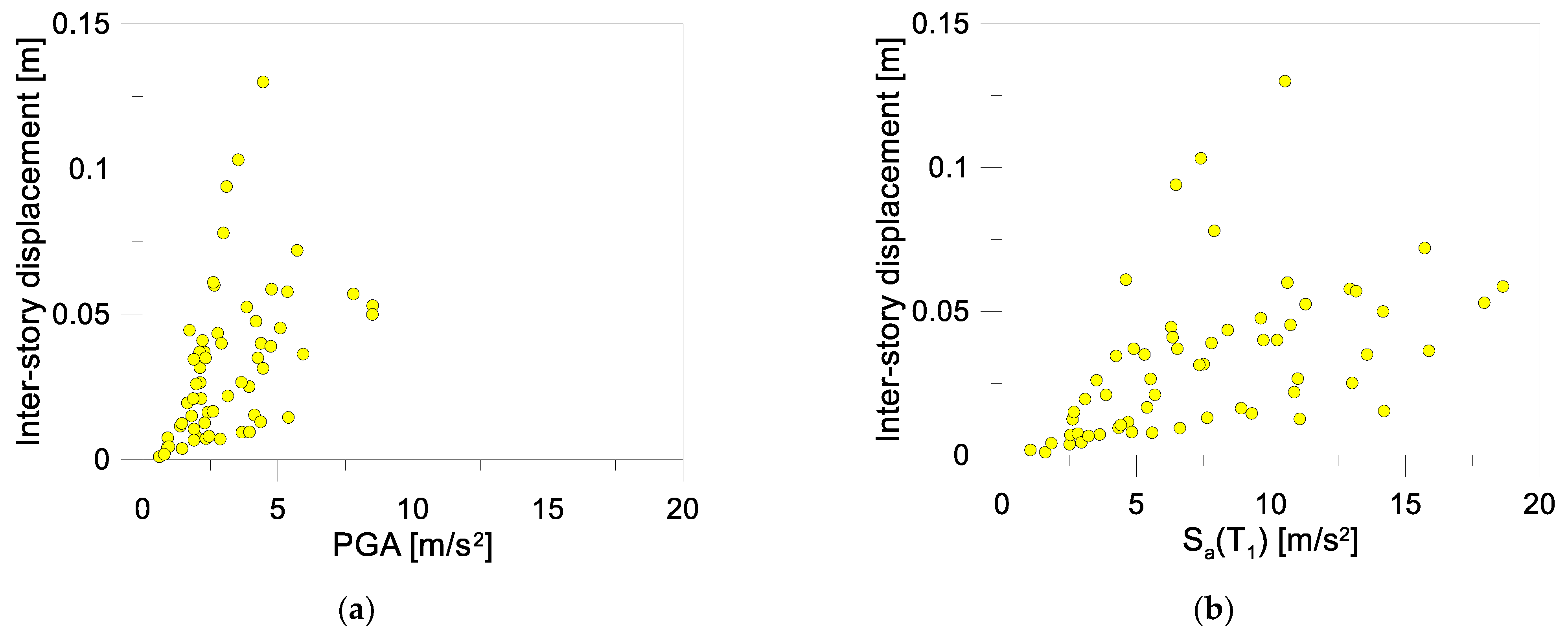
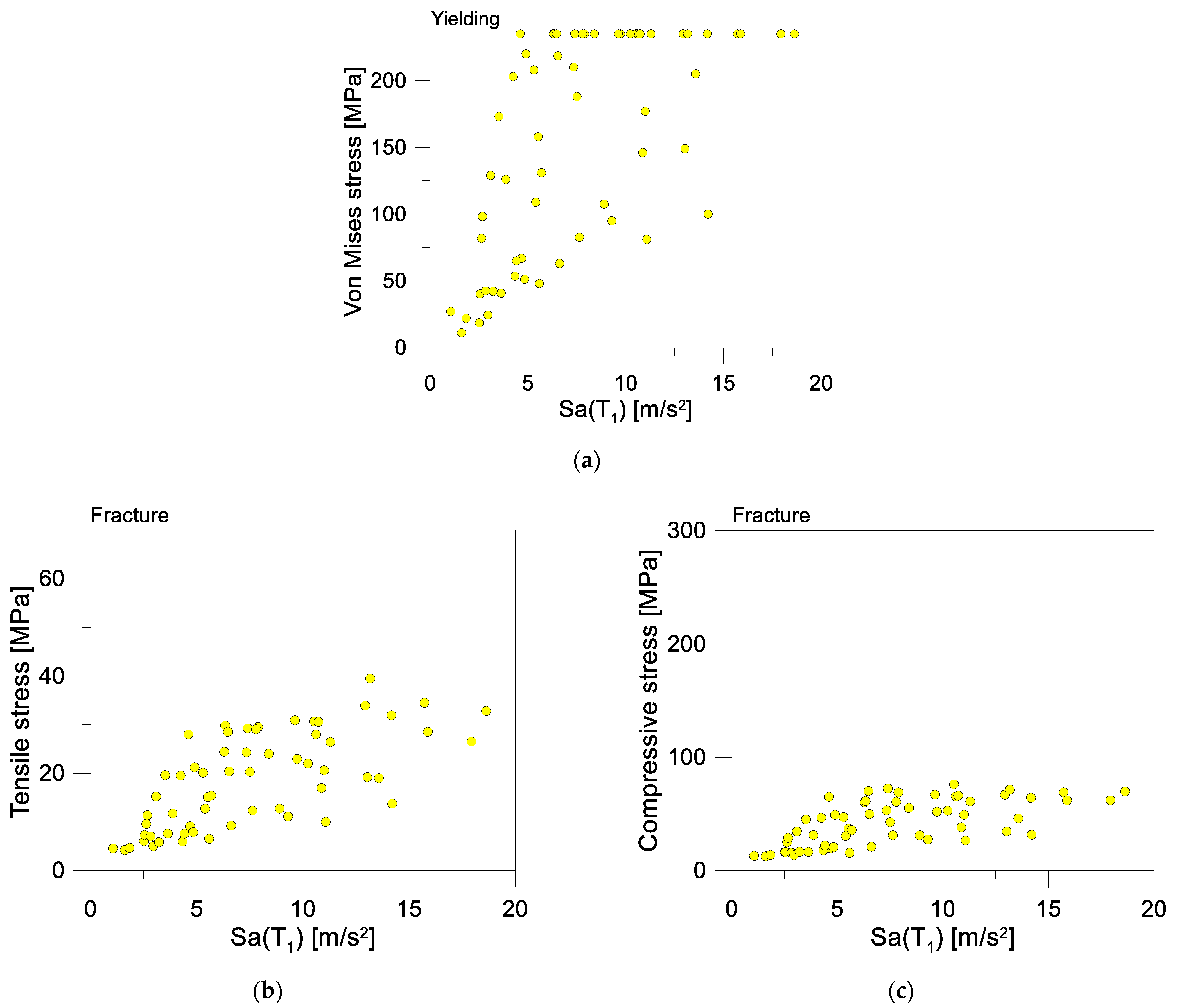
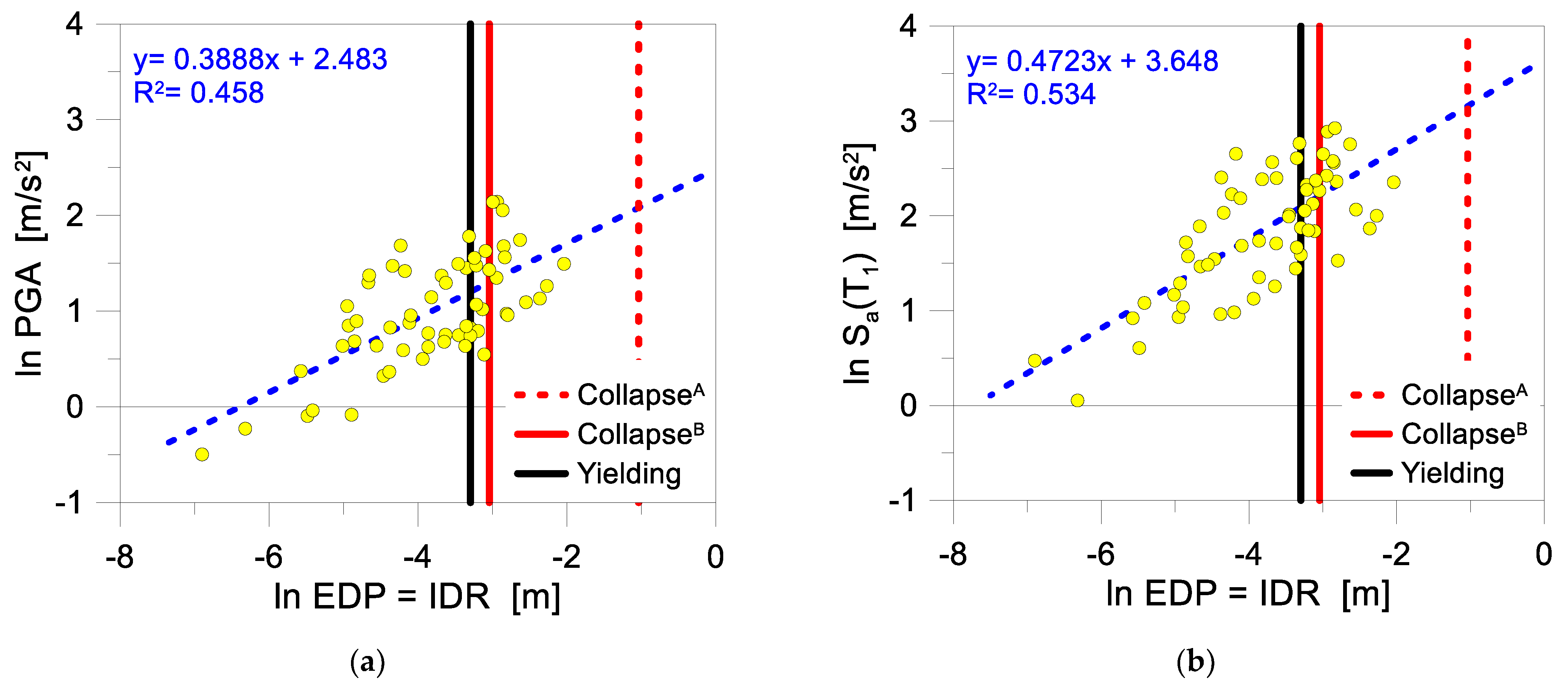
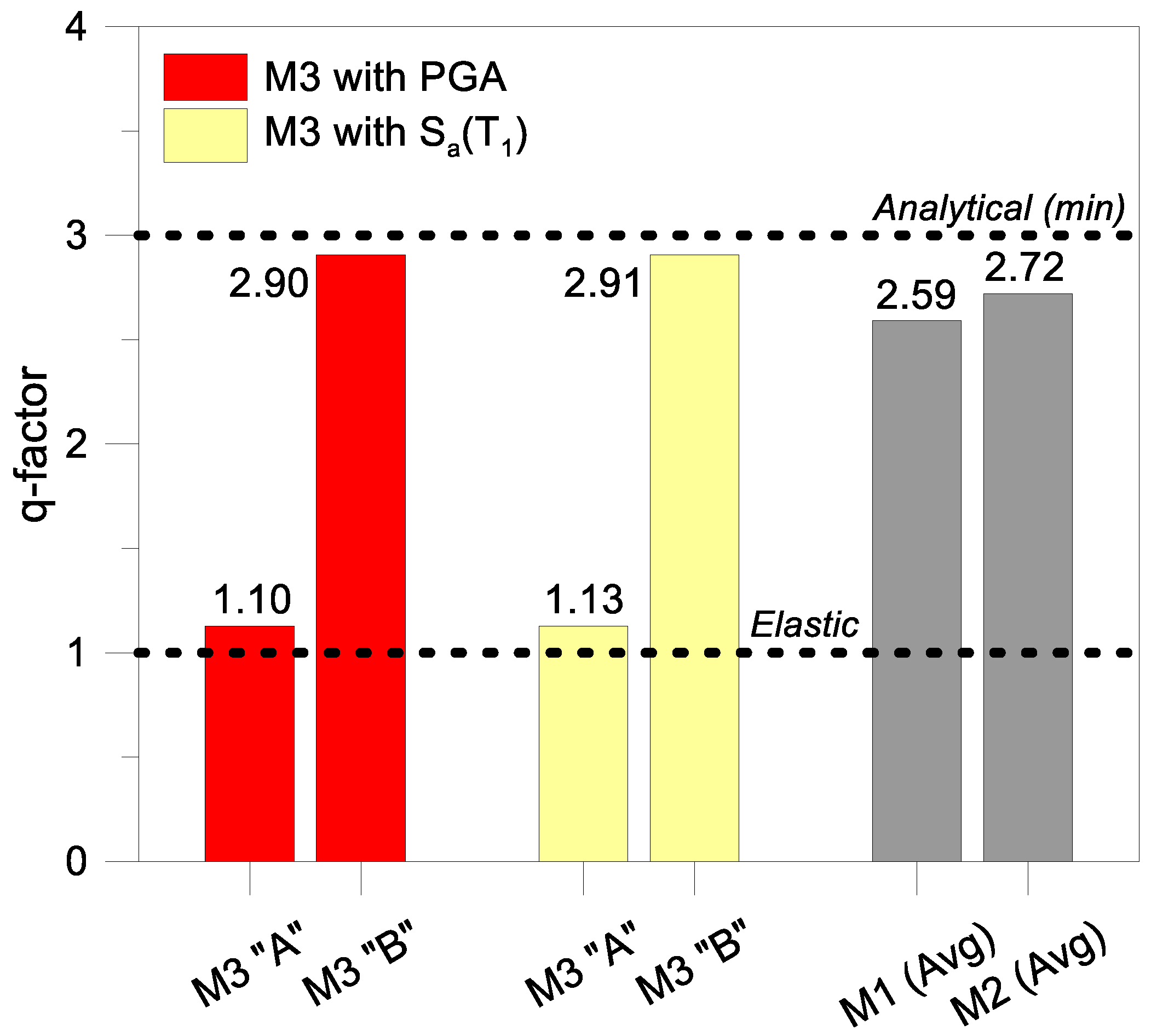
| Limit Drift Value (u/H) | Column Rotation (rad) | |||
|---|---|---|---|---|
| Structural system | FEMA 356 [56] | Vision 2000 [57] | UBC 1997 [58] | EC8, NTC2018 [17,50] |
| Steel braced frames | 0.02 | 0.025 | 0.02 | 0.03 |
| Steel moment frames | 0.05 | |||
Publisher’s Note: MDPI stays neutral with regard to jurisdictional claims in published maps and institutional affiliations. |
© 2021 by the authors. Licensee MDPI, Basel, Switzerland. This article is an open access article distributed under the terms and conditions of the Creative Commons Attribution (CC BY) license (https://creativecommons.org/licenses/by/4.0/).
Share and Cite
Mattei, S.; Fasan, M.; Bedon, C. On the Use of Cloud Analysis for Structural Glass Members under Seismic Events. Sustainability 2021, 13, 9291. https://doi.org/10.3390/su13169291
Mattei S, Fasan M, Bedon C. On the Use of Cloud Analysis for Structural Glass Members under Seismic Events. Sustainability. 2021; 13(16):9291. https://doi.org/10.3390/su13169291
Chicago/Turabian StyleMattei, Silvana, Marco Fasan, and Chiara Bedon. 2021. "On the Use of Cloud Analysis for Structural Glass Members under Seismic Events" Sustainability 13, no. 16: 9291. https://doi.org/10.3390/su13169291
APA StyleMattei, S., Fasan, M., & Bedon, C. (2021). On the Use of Cloud Analysis for Structural Glass Members under Seismic Events. Sustainability, 13(16), 9291. https://doi.org/10.3390/su13169291








